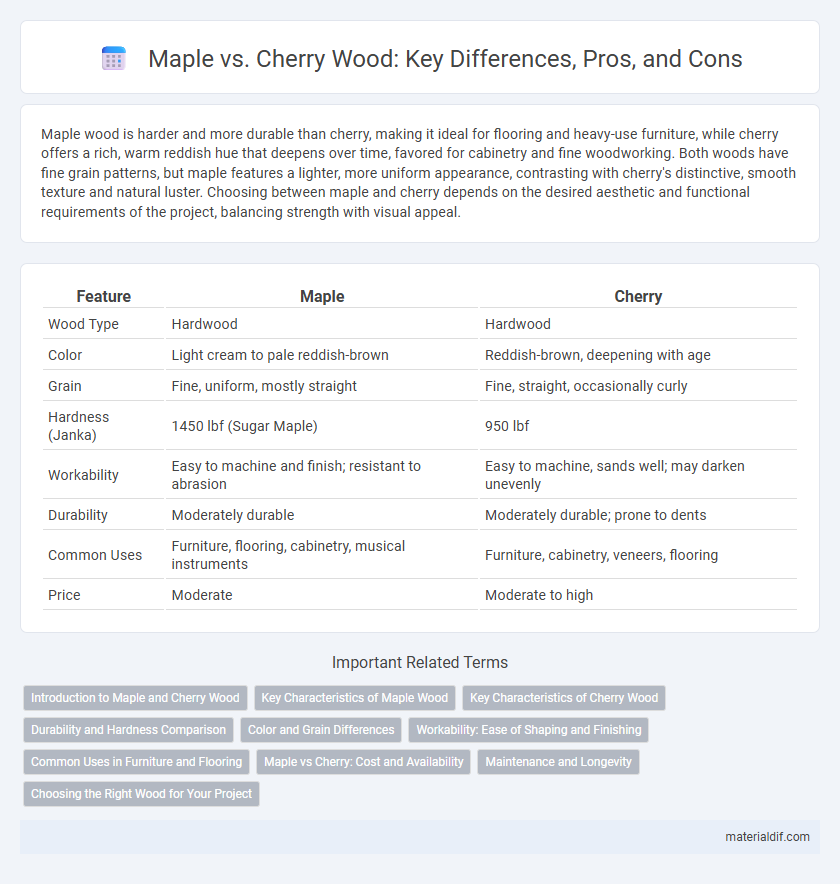Maple wood is harder and more durable than cherry, making it ideal for flooring and heavy-use furniture, while cherry offers a rich, warm reddish hue that deepens over time, favored for cabinetry and fine woodworking. Both woods have fine grain patterns, but maple features a lighter, more uniform appearance, contrasting with cherry's distinctive, smooth texture and natural luster. Choosing between maple and cherry depends on the desired aesthetic and functional requirements of the project, balancing strength with visual appeal.
Table of Comparison
| Feature | Maple | Cherry |
|---|---|---|
| Wood Type | Hardwood | Hardwood |
| Color | Light cream to pale reddish-brown | Reddish-brown, deepening with age |
| Grain | Fine, uniform, mostly straight | Fine, straight, occasionally curly |
| Hardness (Janka) | 1450 lbf (Sugar Maple) | 950 lbf |
| Workability | Easy to machine and finish; resistant to abrasion | Easy to machine, sands well; may darken unevenly |
| Durability | Moderately durable | Moderately durable; prone to dents |
| Common Uses | Furniture, flooring, cabinetry, musical instruments | Furniture, cabinetry, veneers, flooring |
| Price | Moderate | Moderate to high |
Introduction to Maple and Cherry Wood
Maple wood is known for its fine, uniform texture and light color, ranging from creamy white to light reddish-brown, making it a popular choice for furniture, flooring, and cabinetry. Cherry wood, prized for its rich, warm reddish-brown hue and smooth grain, darkens beautifully with age and exposure to light, often used in high-end furniture and decorative veneers. Both hardwoods offer durability and aesthetic appeal, but maple tends to be harder and more resistant to wear, while cherry provides a distinctive, elegant finish valued in traditional woodworking.
Key Characteristics of Maple Wood
Maple wood is known for its durability, fine, uniform texture, and light cream to reddish-brown color, making it ideal for furniture and flooring. It has a high resistance to abrasion and shock, which contributes to its widespread use in cutting boards and kitchen utensils. Compared to cherry wood, maple is denser and harder, providing superior strength but less natural warmth and darker hues.
Key Characteristics of Cherry Wood
Cherry wood is prized for its rich, reddish-brown color that deepens with age and exposure to light, offering a warm and elegant appearance. It features a smooth, fine grain with occasional small knots, providing both visual interest and a uniform texture ideal for furniture and cabinetry. Known for its durability and resistance to warping, cherry wood also has a moderate hardness rating of around 2.5 on the Janka scale, making it suitable for both structural and decorative applications.
Durability and Hardness Comparison
Maple wood exhibits greater hardness with a Janka rating of approximately 1450, making it more resistant to dents and scratches compared to cherry wood, which has a Janka rating of around 950. Cherry wood displays moderate durability but is more prone to dents and wear over time, suitable for furniture that requires a softer touch. Maple's enhanced durability and hardness make it ideal for high-traffic flooring and heavy-use furniture applications.
Color and Grain Differences
Maple wood typically features a light, creamy color with subtle, fine grain patterns, making it ideal for brighter, contemporary spaces. Cherry wood, by contrast, possesses a rich, reddish-brown hue that deepens with age and showcases a smooth, straight grain with occasional waves, lending warmth and elegance to furniture. The pronounced color evolution and distinctive grain of cherry provide a striking contrast to the consistent, pale appearance of maple, influencing design choices in cabinetry and flooring.
Workability: Ease of Shaping and Finishing
Maple offers exceptional workability due to its fine, consistent grain, making it easy to shape and finish smoothly with minimal effort. Cherry wood, while slightly softer, provides excellent workability as well, especially excelling in achieving a rich, polished finish that enhances its warm tones. Both woods respond well to hand and machine tools, but maple's density offers superior resistance to dents during shaping compared to cherry.
Common Uses in Furniture and Flooring
Maple wood is prized for its durability and fine grain, making it ideal for heavy-use furniture such as dressers, cabinets, and flooring that requires high resistance to wear and tear. Cherry wood is valued for its rich, warm color and smooth texture, often used in high-end furniture pieces, including dining tables and elegant interior paneling, where aesthetic appeal is paramount. Both woods are popular in flooring, with maple favored for its hardness and cherry chosen for its sophisticated appearance and ability to develop a deep patina over time.
Maple vs Cherry: Cost and Availability
Maple wood typically costs less than cherry due to its wider availability and faster growth rate, making it a more budget-friendly option for furniture and cabinetry. Cherry wood, prized for its rich color and fine grain, is often more expensive because it grows slower and is less abundant. Both woods are commonly found in hardwood suppliers, but regional availability can impact their price and accessibility.
Maintenance and Longevity
Maple wood offers superior durability and requires less frequent maintenance compared to cherry wood, making it ideal for high-traffic areas. Cherry wood, while aesthetically rich with its warm tones, tends to darken over time and demands regular upkeep to maintain its appearance. Both woods benefit from periodic sealing, but maple's natural hardness extends its longevity under everyday wear.
Choosing the Right Wood for Your Project
Maple offers exceptional hardness and durability, making it ideal for high-traffic furniture and flooring projects that require long-lasting wear resistance. Cherry wood provides a rich, warm coloration with a smooth grain, perfect for fine cabinetry and decorative pieces that benefit from its elegant aging process. Selecting the right wood depends on balancing the need for strength and aesthetic appeal tailored to the specific use and style of your project.
Maple vs Cherry Infographic

 materialdif.com
materialdif.com